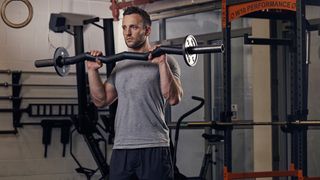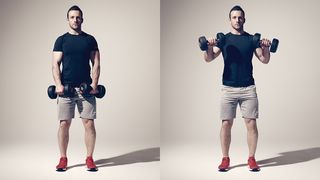The Surprising Benefits Of Reverse Curls
Reverse curls can be your secret weapon in your quest to build bigger arms and a bigger body. We explain why and how to do them

When did you last do a biceps curl? If you’re a regular in the weights room, we’d wager it was in the last week. Indeed, we’d guess that even if you only worked out once in the last week then the classic dumbbell curl featured. But when did you last do a reverse biceps curl? That’s the variation in which, instead of curling a weight up with wrists turned so your palms face upwards and towards you, you perform it with your palms facing down and away from you.
We’d bet it wasn’t in the last week and almost certainly not in the last month—if ever. If that’s true, you’re missing out on a move that doesn’t just help you develop bigger biceps, but ultimately adds muscular size and strength all over your frame because of the improvement to forearm and grip strength, which in turn better equips you to lift heavier in almost every other gym-based move.
Weight training progress is always limited by the weakest point—which for most men is poor grip strength—so developing that area will help you to lift heavier and for longer on all the big compound lifts that should form the core of your training, such as deadlifts, chin-ups and pull-ups, and rows.
Read on to discover how and when to include more reverse curls in your training.
How To Perform A Reverse Curl

When performing a reverse curl you can either use dumbbells, or an EZ curl bar or a straight barbell like an Olympic bar. Don’t go in thinking that you can lift a similar weight to what you can with an underhand grip, the short answer is: you can’t. Start with around half of the weight that you’d usually use for a regular barbell curl for 8 reps. Of course, you can increase it after a set or two but it’s important to get your form right, so a lighter weight should suffice to begin with.
Grab the bar with a shoulder-width grip with your hands on top of the bar (pronated grip), not underneath as they would be with a regular curl. If you are using an EZ curl bar grip it on the downward-sloping parts of the bar, found just outside the middle straight section.
For correct form ensure that your elbows are kept close to your sides with your knees slightly bent, and your hands gripped tightly to the bar, curl it up as you would with a regular curl. The pronated grip that you are using will engage the brachialis muscles in order for you to be able to move the weight. Feel the tension in your forearms as you come toward the top of the curl, hold for a second or two here at then lower slowly. You’ll feel the blood rush to different parts of your arm than you would with a regular curl, stimulating growth in new areas.
Get the Coach Newsletter
Sign up for workout ideas, training advice, reviews of the latest gear and more.
Reverse Curl Form Tips
Try to bring your elbows slightly together as you perform the curl
This will help to increase the contraction of the brachialis at the very top of the movement. Imagine that you are rotating your arms inward as you are curling the bar upward.
Let your wrists flex back when you come to the top of the curl
Try to do this while raising your elbows until they are pointing directly forward. This will resemble the arm position taken up for a front squat. You’ll get a better contraction of the brachialis muscles this way.
If performing the move with the EZ bar, do not grip it with your thumbs against the top of the bars slope
Ensure that you grip the bar at the bottom of the slope. If you grip at the top you will be bracing your thumb against the centre section of the bar, which will decrease the work that your forearm and gripping muscles have to do. If you grip at the bottom of the slope you won’t get the bracing effect resulting in more tension on the targeted muscles.
Perform reverse curls at the end of a biceps workout
When your arms are nice and weak, shock them with a new move to stimulate growth. Just two or three sets at the end of a biceps or arms workout should be enough.

Joe Warner is a highly experienced journalist and editor who began working in fitness media in 2008. He has featured on the cover of Men’s Fitness UK twice and has co-authored Amazon best-sellers including 12-Week Body Plan. He was the editor of Men’s Fitness UK magazine between 2016 and 2019, when that title shared a website with Coach.
